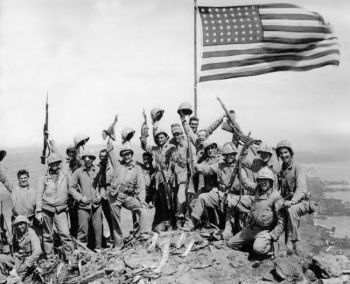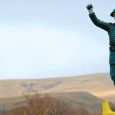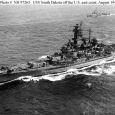The Gift of South Dakota
Subscriptions to South Dakota Magazine make great gifts!
Subscribe today — 1 year (6 issues) is just $29!
Unknown No More
Jack Thurman remembers the photograph as if it were taken yesterday. He was standing on the slope of Mount Suribachi on the Japanese island of Iwo Jima. It was the 25th or 26th of February, 1945. American forces were in the heat of a battle with the Japanese for control of the small island about 650 miles south of Tokyo. As a member of the United States Marine Corps’ 5th Division, 27th Regiment, Thurman had volunteered to help the 28th Regiment secure the mountain. They had been on Iwo Jima since the 19th. They were making progress.
On the 23rd a group of Marines made it to the top of Mount Suribachi and hoisted an American flag. A few days later, Associated Press photographer Joe Rosenthal gathered those soldiers again for another photo around the flag. One of them noticed Thurman standing a few yards down the mountain and invited him up. After the photo was taken, the soldiers returned to the fight and Rosenthal left with another good war picture. In this one the soldiers were jubilant. Some held their helmets in the air. Others raised their guns. Rosenthal was able to identify everyone except one man — Thurman.
For more than 55 years, the smiling young Marine standing on the far left side of the photo was identified only as “unknown.” But his name is no longer a mystery. After years of silence, Thurman identified himself as the only unknown soldier in that image from Iwo Jima.
Thurman, the oldest of 15 children, grew up on a dairy farm outside of Mitchell. He remembers “a lot of hard work,” milking cows and farming with a team of horses (Thurman’s father finally bought a tractor in 1939). He rode a horse to country school before enrolling at Notre Dame School in Mitchell.
When the United States entered World War II in December 1941, thousands of young men across the country clamored to join the military. Thurman was no different. When he was 17, he told his family he wanted to enlist, but his father wouldn’t sign the necessary paperwork, saying he needed him on the farm. So Thurman waited until Sept. 27, 1943, his 18th birthday. He walked into the recruiter’s office in Mitchell and joined the Marine Corps.
"As I looked over my right shoulder, I saw that flag going up...it was the most beautiful thing I ever saw in my life."
After training at Fort Snelling, Minn., and San Diego, Thurman became a member of Carlson’s Raiders in the South Pacific. In early 1945, Thurman found himself on a ship heading west from Hawaii. Only after a few days at sea did the Marines find out they were headed for Iwo Jima. As they approached the island they saw nearly constant gun flashes along the horizon. “We were all thinking to ourselves, ‘How can anything survive on that island with that kind of an attack?’” Thurman recalled.
On Feb. 19 the 5th Division’s 26th, 27th and 28th regiments landed on the southern coast of Iwo Jima. Thurman remembers chills running down his spine as he stepped over dead Japanese soldiers lying on the black sands of Iwo Jima’s beach. “We didn’t know what to expect,” he says.
The 28th Regiment was assigned to take Mount Suribachi, an inactive volcano on the southern tip of the island. The 26th and Thurman’s 27th Regiment were to take an airstrip that sat just a few hundred yards northeast of Mount Suribachi. The Marines set to work, firing on foxholes and rooting out Japanese soldiers, many of whom were hidden within 11 miles of tunnels.
While Thurman and other members of his regiment fought the Japanese on the ground, the 28th Regiment started its slow ascent up Mount Suribachi. On Feb. 21 the men had nearly surrounded the base of the mountain and started to climb. At a little after 10 a.m., on the morning of the 23rd, as Thurman was fighting in the middle of the airstrip, a soldier noticed activity on the mountaintop. Marines had reached the summit and were raising a flag. “As I looked over my right shoulder, I saw that flag going up,” Thurman said. “It was the most beautiful thing I ever saw in my life. The ocean breeze hit it and the flag itself unfurled. It was just a beautiful thing up there. And there were a few of us who had some tears in our eyes, because we lost a lot of men between the 19th of February and the 23rd of February. We lost a lot of men, so we weren’t ashamed to shed a tear.”
Marine Corps photographer Lou Lowery captured the first flag raising. A few hours later, another group of Marines reached the top of the mountain with a larger flag. As they took the smaller one down and hoisted the bigger flag into place, Rosenthal snapped a picture. The image, which was given the title “Raising the Flag on Iwo Jima,” won a Pulitzer Prize and became one of the most reproduced photos of the war.
Thurman was a bit hesitant days later when that soldier from the 28th Regiment invited him into Rosenthal’s group photo. “I said, ‘Well I’m 27th Regiment.’ And he said, ‘That makes no difference. You’re still one of us.’ Well, that sounded pretty good to me,” Thurman said, “so I went up.”
Thurman is standing directly behind Ira Hayes, one of the six men immortalized in Rosenthal’s flag-raising photo. John Bradley, Franklin Sousey and Mike Strank—three other soldiers from the flag raising—are also in the photo. As the only man who was not a member of the 28th Regiment, Thurman became the only unidentified soldier.
Many of the men standing alongside Thurman, including Sousley and Strank, were killed days later as the Japanese continued their attempt to hold Iwo Jima. The fighting continued until American forces finally secured the island on March 26, 1945. Thurman left Iwo Jima that same day.
In a few months the war was over. Thurman came back to the United States and bounced around the West Coast looking for work before coming back to South Dakota. He had a number of jobs in Mitchell, Aberdeen and Rapid City before he and his wife, Carol, headed for San Diego. It was there that he was introduced to drafting and embarked upon a career in architecture. He finally settled down in Boulder, Colo., where he designed many of the buildings on the University of Colorado campus.
After years of silence, Thurman identified himself as the only unknown soldier in that image of Iwo Jima.
For more than 30 years after the war Thurman remained silent about what he had experienced. “I just didn’t particularly care to talk about it,” he said. “It was hard for me to hold back my emotions when I got into the real messy part.” In the late 1970s, though, Thurman was invited to speak at a Denver-area Kiwanis Club. Since then he has been open about his war experiences and has written a book detailing his military career.
The country was re-introduced to Iwo Jima in 2000 with the publication of Flags of Our Fathers. Written by John Bradley’s son James, the book chronicles the lives of the six men who raised the flag on Iwo Jima. The picture of those men from the 28th Regiment, plus an unknown Marine, gathered on Mount Suribachi is included in a section of photographs from the battle.
After the book came out, Thurman’s family members and friends were sure they knew the unidentified soldier. “People in the family were calling me asking ‘Isn’t that you in that picture?’” By saying yes, Thurman finally ended a half-century of mystery.
In 2006 Clint Eastwood turned Flags of Our Fathers into a movie. Thurman saw the film in Denver with a host of other Iwo Jima veterans. Shortly before Christmas that year, Thurman met Lt. Keith Wells, the platoon leader whose men were charged with putting the flag on Mount Suribachi.
“So you’re the guy in that picture?” Wells asked.
“Yes, sir,” Thurman said.
“We’ve been wondering who in the hell that guy is,” Wells said. “We could not figure out who he was. We’ve got a name for everybody but that one.”
“Well,” Thurman answered, with a laugh, “I’m the lone ranger.”
Editor's Note: This story is revised from the March/April 2008 issue of South Dakota Magazine. To order a back issue or to subscribe, call 800-456-5117.











Comments